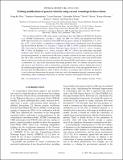Probing modifications of general relativity using current cosmological observations
Author(s)
Zhao, Gong-Bo; Giannantonio, Tommaso; Pogosian, Levon; Silvestri, Alessandra; Bacon, David J.; Koyama, Kazuya; Nichol, Robert C.; Song, Yong-Seon; ... Show more Show less
DownloadZhao-2010-Probing modification.pdf (993.5Kb)
PUBLISHER_POLICY
Publisher Policy
Article is made available in accordance with the publisher's policy and may be subject to US copyright law. Please refer to the publisher's site for terms of use.
Terms of use
Metadata
Show full item recordAbstract
We test general relativity (GR) using current cosmological data: the CMB from WMAP5 [E. Komatsu et al. (WMAP Collaboration), Astrophys. J. Suppl. Ser. 180, 330 (2009)], the integrated Sachs-Wolfe (ISW) effect from the cross correlation of the CMB with six galaxy catalogs [T. Giannantonio et al., Phys. Rev. D 77, 123520 (2008)], a compilation of supernovae (SNe) type Ia including the latest Sloan Digital Sky Survey SNe [R. Kessler et al., Astrophys. J. Suppl. Ser. 185, 32 (2009).], and part of the weak lensing (WL) data from the Canada-Franco-Hawaii Telescope Legacy Survey [L. Fu et al., Astron. Astrophys. 479, 9 (2008); M. Kilbinger et al., Astron. Astrophys. 497, 677 (2009).] that probe linear and mildly nonlinear scales. We first test a model in which the effective Newtonian constant mu and the ratio of the two gravitational potentials, eta, transit from the GR value to another constant at late times; in this case, we find that GR is fully consistent with the combined data. The strongest constraint comes from the ISW effect which would arise from this gravitational transition; the observed ISW signal imposes a tight constraint on a combination of mu and eta that characterizes the lensing potential. Next, we consider four pixels in time and space for each function mu and eta, and perform a principal component analysis, finding that seven of the resulting eight eigenmodes are consistent with GR within the errors. Only one eigenmode shows a 2sigma deviation from the GR prediction, which is likely to be due to a systematic effect. However, the detection of such a deviation demonstrates the power of our time- and scale-dependent principal component analysis methodology when combining observations of structure formation and expansion history to test GR.
Date issued
2010-05Department
Massachusetts Institute of Technology. Department of Physics; MIT Kavli Institute for Astrophysics and Space ResearchJournal
Physical Review D
Publisher
American Physical Society
Citation
Zhao, Gong-Bo et al. “Probing modifications of general relativity using current cosmological observations.” Physical Review D 81.10 (2010): 103510. © 2010 The American Physical Society.
Version: Final published version
ISSN
1550-7998